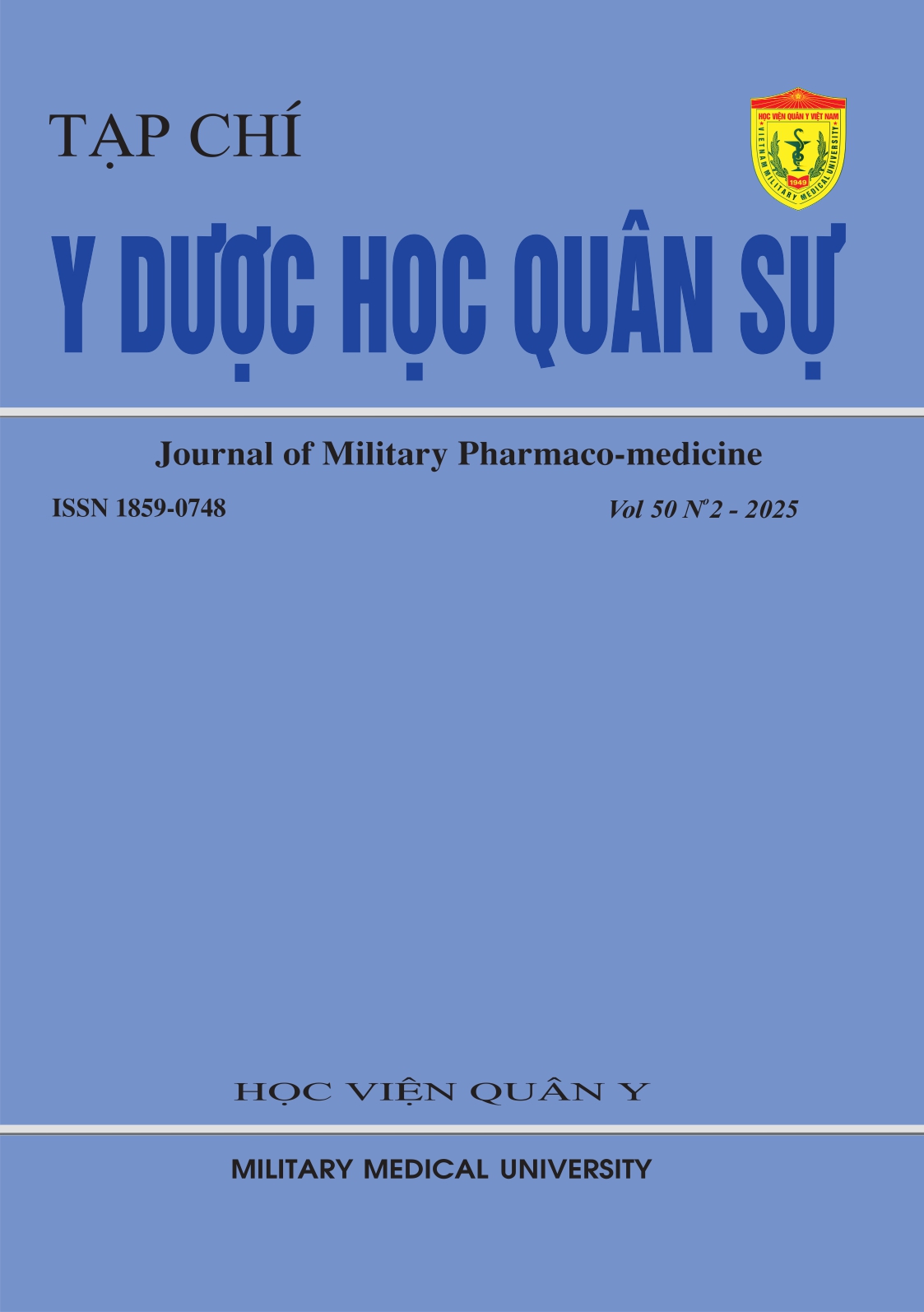TREATMENT RESULTS OF CONCURRENT CHEMORADIOTHERAPY FOR LOCOREGIONAL ADVANCED STAGE OF ESOPHAGEAL CANCER
Main Article Content
Abstract
Objective: Evaluating the treatment results of concurrent chemoradiotherapy for locoregionally advanced esophageal cancer and analyzing some related factors. Subject and method: cross-sectional, retrospective, longitudinal follow-up, no control on 61 patients who were diagnosed with squamous cell carcinoma esophagus, regardless of age and gender; treated with concurrent chemoradiotherapy using 3D radiotherapy technique with Paclitaxel-carboplatin regimen in weekly cycles at Military Hospital 103 from January 2019 to November 2022. Result: The mean age was 56.8 (32-75), 100.0% was male. Preoperative radiotherapy with a radiation dose of 41.4Gy and 5 cycles of chemotherapy accounted for 65.6%; 34.4% of patients received radical radiotherapy with a radiation dose of 50.4Gy and 6 cycles of chemotherapy). Patients had clinical respone after treatment accounted for 80.3%. Symptoms of dysphagia were significantly reduced after treatment (p < 0.001). The response rate was 81.9%, with the highest rate of partial response patients (55.7%) according to RECIST 1.1 criteria. The progression rate during chemotherapy and radiotherapy was low (3.3%). The regimen was safe, with only mild complications, and dermatitis had the highest rate (67.0%). Analysis showed that better patient status, earlier disease stage according to T, N, and TNM were predictive factors for better response after treatment (p < 0.05). Conclusion: Concurrent preoperative and radical chemoradiotherapy is effective and well tolerated. This is a suitable treatment method for patients with esophageal cancer without distant metastasis.
Article Details
Keywords
chemoradiotherapy, Esophageal cancer, Locoregional advanced stage
References
2. Huang FL and Yu SJ. Esophageal cancer: Risk factors, genetic association, and treatment. Asian J Surg. 2018; 41(3):210-215.
3. Nguyễn Thị Hà. Kết quả hóa xạ trị đồng thời tiền phẫu ung thư thực quản 1/3 giữa - dưới giai đoạn II,III tại Bệnh viện TWQĐ 108. Luận văn Thạc sỹ Y học, Trường Đại học Y Hà Nội. 2021.
4. Nguyễn Trọng Tiến. Đánh giá kết quả hóa xạ trị Vmat kết hợp đồng thời hóa chất trong ung thư thực quản 1/3 trên tại Bệnh viện K. Luận văn Thạc sỹ Y học, Trường Đại học Y Hà Nội.2019
5. Shapiro J, van Lanschot JJB, Hulshof MCCM, et al. Neoadjuvant chemoradiotherapy plus surgery versus surgery alone for oesophageal or junctional cancer (CROSS): Long-term results of a randomised controlled trial. The Lancet Oncology. 2015; 16(9):1090-1098.
6. Sridhar P, Bhatt M, Qureshi MM, et al. Esophageal cancer presentation, treatment, and outcomes vary with hospital safety-net burden. Ann Thorac Surg. 2019; 107(5):1472-1479.
7. Ishibashi Y, Tsujimoto H, Hiraki S, et al. Prognostic value of preoperative systemic immunoinflammatory measures in patients with esophageal cancer. Ann Surg Oncol. 2018; 25(11):3288-32998.
8. Nguyễn Đức Lợi. Đánh giá hiệu quả phác đồ hóa xạ trị đồng thời và một số yếu tố tiên lượng ung thư biểu mô thực quản giai đoạn III, IV tại Bệnh viện K. Luận án Tiến sĩ Y học, Trường Đại học Y Hà Nội. 2015.
9. Nguyễn Thị Tố Quyên. Đánh giá kết quả hóa xạ trị đồng thời phác đồ PC hàng tuần ung thư thực quản giai đoạn III-IVA tại bệnh viện ung bướu Thanh Hóa. Luận văn Thạc sỹ Y học, Trường Đại học Y Hà Nội. 2019.
10. Zhu S, Miao CW, Wang ZT, et al. Sensitivity value of hematological markers in patients receiving chemoradiotherapy for esophageal squamous cell carcinoma. Onco Targets Ther. 2016; 9:6187-6193.


